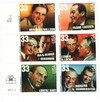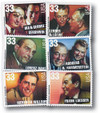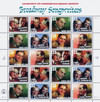
1999 33c Broadway Songwriters
# 3345-50 - 1999 33c Broadway Songwriters
$3.00 - $26.00
U.S. #3345-50
33¢ Broadway Songwriters
33¢ Broadway Songwriters
Issue Date: September 21, 1999
City: New York, NY
Quantity: 6,375,000
Printed By: Sterling Sommer for Ashton-Potter (USA) Ltd
Printing Method: Lithographed
Perforations: 11
Color: Multicolored
City: New York, NY
Quantity: 6,375,000
Printed By: Sterling Sommer for Ashton-Potter (USA) Ltd
Printing Method: Lithographed
Perforations: 11
Color: Multicolored
George and Ira Gershwin
George and Ira Gershwin made up one of the most important musical teams in American history. The sons of Russian immigrants, George and Ira’s original names were Jacob and Israel Gershvin. Early in their lives, George (1898-1937) began studying the piano and Ira (1896-1983) demonstrated a talent for writing. The first song they composed together was “The Real American Folk Song” (1918).
George experienced early success with his song “Swanee,” which was made popular by performer Al Jolson. The first production for which he wrote the entire score was “La, La Lucille” (1919). George continued to write songs for various productions during the early 1920s. His first major Broadway success came in 1924 with “Lady Be Good.” This musical was the first large-scale work completed by George and Ira Gershwin.
Ira Gershwin collaborated with his brother on more than 20 productions. His songs include “I Got Rhythm,” “Embraceable You,” and “A Foggy Day.” One of George Gershwin’s greatest ambitions was to create an American opera. In 1935, the Gershwins collaborated with author DuBose Heyward to create “Porgy and Bess” (1935), based on Heyward’s novel. This was George and Ira Gershwin’s last major work together.
Lerner and Loewe
Alan Jay Lerner (1918-1986) and Frederick Loewe (1904-1988) met in 1942. Together, they created some of the most memorable musicals in Broadway history.
Born in Vienna, Austria, Frederick Loewe was a child prodigy. He began playing piano at the age of five, composing at age seven, and at 13 was the youngest soloist to appear with the Berlin Symphony Orchestra. When he was 15 years old, Loewe’s song “Katrina” became popular, selling over 1 million copies of sheet music. He arrived in the United States in 1924.
Alan Jay Lerner, the son of prosperous shop owners, was educated in England, Connecticut, at the Juilliard School of Music in New York City, and Harvard. Before meeting Loewe, Lerner wrote radio scripts.
The 1947 production “Brigadoon” gave Lerner and Loewe their first success. Their fifth musical, “My Fair Lady,” (1956) was a huge hit. It was based on George Bernard Shaw’s “Pygmalion.” “My Fair Lady” was translated into 11 languages, performed in over 20 countries, and had the longest original run of any musical in New York City or London. In 1964, a film version of the show was released. It won eight Academy Awards.
Lerner and Loewe’s work “Gigi” (1958) was created directly for film. It received nine Academy Awards.
Lorenz Hart
Lorenz Hart (1895-1943) created the lyrics to some of the greatest popular songs. He became famous for the songs that he and Richard Rodgers wrote for musical comedies. Their 25-year partnership produced over 1,000 songs, including “With a Song in My Heart,” “The Lady is a Tramp,” and “My Funny Valentine.”
Hart worked as a German translator while attending Columbia University in New York City. At the age of 23, Hart met Rodgers, who was 16. They began writing and composing numbers immediately. “The Garrick Gaieties” (1925) was their first successful Broadway musical. Other works by Hart and Rodgers are “Peggy Ann” (1926) and “A Connecticut Yankee” (1927).
In the early 1930s, Hart and Rodgers were drawn to Hollywood, where they composed songs for motion pictures. They returned to Broadway in 1935, and continued to write musicals. A few of their works from this time are “The Boys From Syracuse” (1938) and “Pal Joey” (1940), which was perhaps their biggest hit.
Throughout their professional relationship, Rodgers remained a reserved and disciplined worker, while Hart was the gifted amateur. The last show Lorenz Hart and Richard Rodgers created together was “By Jupiter” (1942), which added to the duo’s long list of musical hits.
Rodgers and Hammerstein
Richard Rodgers and Oscar Hammerstein II created productions that took musical theater to new levels. Rodgers (1902-1979) began composing songs as a youth. A few of his numbers appeared on Broadway when he was just a teenager. In 1918, Rodgers met his first partner, Lorenz Hart, at Columbia University. They created many successful musicals, including “Pal Joey” (1940). Their partnership had ended by 1943.
Oscar Hammerstein (1895-1960) studied law at Columbia University before his career in the theater. He wrote many musical dramas for stage, television, and film before becoming Rodger’s partner in 1943.
The first product of Rodgers and Hammerstein’s relationship was “Oklahoma!” (1943). The musical was a huge hit and ran on Broadway for over 2,000 performances. It won a Pulitzer Prize in 1944. The duo won a second Pulitzer in 1950 for “South Pacific.”
Rodgers and Hammerstein’s 17-year relationship produced such songs as “I’m Gonna Wash That Man Right Outa My Hair,” “The Surrey With the Fringe on Top,” and “Oh, What A Beautiful Mornin’.” Their three other successful musicals were “Carousel” (1945), “The King and I” (1951), and “The Sound of Music” (1959), which was their last show.
Meredith Willson
Meredith Willson (1902-1984) distinguished himself as a writer of symphonic works and popular songs. He earned lasting fame for his series of Broadway hits, especially “The Music Man” (1957). The idea for the show began in 1949, when he was reminiscing with friends about his childhood years in Mason City, Iowa.
Willson proved to be a talented musician at a young age. Early in his life he studied the piano, piccolo, and flute. He attended the Institute of Musical Art (later called the Juilliard School of Music) in New York City, and was a flutist in John Philip Sousa’s band. He also played with the New York Philharmonic, and worked at the National Broadcasting Company.
“The Music Man” is Willson’s most famous musical. The story centers around an unscrupulous con man named Harold Hill, who tries to sell non-existent musical instruments to the citizens of River City, Iowa. But he ends up falling in love with the town librarian.
After it opened on Broadway in 1957, “The Music Man” ran for a marathon 1,375 performances. Willson’s award-winning score includes the songs “Seventy-six Trombones,” “Trouble,” and “Till There Was You,” which was a hit for the Beatles in 1963. Willson also wrote the musical “The Unsinkable Molly Brown” (1960).
Frank Loesser
Frank Loesser (1910-1969) was one of Broadway’s best composers, lyricists, and producers. Born in New York City, Loesser left college in 1926 and took a variety of odd jobs, including newspaper reporter. He also wrote sketches and lyrics for vaudeville acts.
Loesser was a singer at a New York City nightclub in the early 1930s. A few of his songs were included in the revue “The Illustrator’s Show” (1936). This earned Loesser a contract with Universal Pictures. He later joined Paramount, and spent 11 years in Hollywood.
While serving with the Army during World War II, Loesser had a hit with the song “Praise the Lord and Pass the Ammunition.” After he returned home, Loesser wrote the music and lyrics for “Where’s Charley?” which opened in 1948 and ran for nearly 800 performances.
The lyricist’s next undertaking was based on the short story “The Idyll of Miss Sarah Brown.” The title of the musical became “Guys and Dolls” (1950). Ranked as one of the finest in history, the musical was performed over 1,200 times in its original run on Broadway. Loesser’s successful musical career culminated with his blockbusting satire, “How To Succeed in Business Without Really Trying” (1961). He received the Pulitzer Prize in 1962 for the show.
U.S. #3345-50
33¢ Broadway Songwriters
33¢ Broadway Songwriters
Issue Date: September 21, 1999
City: New York, NY
Quantity: 6,375,000
Printed By: Sterling Sommer for Ashton-Potter (USA) Ltd
Printing Method: Lithographed
Perforations: 11
Color: Multicolored
City: New York, NY
Quantity: 6,375,000
Printed By: Sterling Sommer for Ashton-Potter (USA) Ltd
Printing Method: Lithographed
Perforations: 11
Color: Multicolored
George and Ira Gershwin
George and Ira Gershwin made up one of the most important musical teams in American history. The sons of Russian immigrants, George and Ira’s original names were Jacob and Israel Gershvin. Early in their lives, George (1898-1937) began studying the piano and Ira (1896-1983) demonstrated a talent for writing. The first song they composed together was “The Real American Folk Song” (1918).
George experienced early success with his song “Swanee,” which was made popular by performer Al Jolson. The first production for which he wrote the entire score was “La, La Lucille” (1919). George continued to write songs for various productions during the early 1920s. His first major Broadway success came in 1924 with “Lady Be Good.” This musical was the first large-scale work completed by George and Ira Gershwin.
Ira Gershwin collaborated with his brother on more than 20 productions. His songs include “I Got Rhythm,” “Embraceable You,” and “A Foggy Day.” One of George Gershwin’s greatest ambitions was to create an American opera. In 1935, the Gershwins collaborated with author DuBose Heyward to create “Porgy and Bess” (1935), based on Heyward’s novel. This was George and Ira Gershwin’s last major work together.
Lerner and Loewe
Alan Jay Lerner (1918-1986) and Frederick Loewe (1904-1988) met in 1942. Together, they created some of the most memorable musicals in Broadway history.
Born in Vienna, Austria, Frederick Loewe was a child prodigy. He began playing piano at the age of five, composing at age seven, and at 13 was the youngest soloist to appear with the Berlin Symphony Orchestra. When he was 15 years old, Loewe’s song “Katrina” became popular, selling over 1 million copies of sheet music. He arrived in the United States in 1924.
Alan Jay Lerner, the son of prosperous shop owners, was educated in England, Connecticut, at the Juilliard School of Music in New York City, and Harvard. Before meeting Loewe, Lerner wrote radio scripts.
The 1947 production “Brigadoon” gave Lerner and Loewe their first success. Their fifth musical, “My Fair Lady,” (1956) was a huge hit. It was based on George Bernard Shaw’s “Pygmalion.” “My Fair Lady” was translated into 11 languages, performed in over 20 countries, and had the longest original run of any musical in New York City or London. In 1964, a film version of the show was released. It won eight Academy Awards.
Lerner and Loewe’s work “Gigi” (1958) was created directly for film. It received nine Academy Awards.
Lorenz Hart
Lorenz Hart (1895-1943) created the lyrics to some of the greatest popular songs. He became famous for the songs that he and Richard Rodgers wrote for musical comedies. Their 25-year partnership produced over 1,000 songs, including “With a Song in My Heart,” “The Lady is a Tramp,” and “My Funny Valentine.”
Hart worked as a German translator while attending Columbia University in New York City. At the age of 23, Hart met Rodgers, who was 16. They began writing and composing numbers immediately. “The Garrick Gaieties” (1925) was their first successful Broadway musical. Other works by Hart and Rodgers are “Peggy Ann” (1926) and “A Connecticut Yankee” (1927).
In the early 1930s, Hart and Rodgers were drawn to Hollywood, where they composed songs for motion pictures. They returned to Broadway in 1935, and continued to write musicals. A few of their works from this time are “The Boys From Syracuse” (1938) and “Pal Joey” (1940), which was perhaps their biggest hit.
Throughout their professional relationship, Rodgers remained a reserved and disciplined worker, while Hart was the gifted amateur. The last show Lorenz Hart and Richard Rodgers created together was “By Jupiter” (1942), which added to the duo’s long list of musical hits.
Rodgers and Hammerstein
Richard Rodgers and Oscar Hammerstein II created productions that took musical theater to new levels. Rodgers (1902-1979) began composing songs as a youth. A few of his numbers appeared on Broadway when he was just a teenager. In 1918, Rodgers met his first partner, Lorenz Hart, at Columbia University. They created many successful musicals, including “Pal Joey” (1940). Their partnership had ended by 1943.
Oscar Hammerstein (1895-1960) studied law at Columbia University before his career in the theater. He wrote many musical dramas for stage, television, and film before becoming Rodger’s partner in 1943.
The first product of Rodgers and Hammerstein’s relationship was “Oklahoma!” (1943). The musical was a huge hit and ran on Broadway for over 2,000 performances. It won a Pulitzer Prize in 1944. The duo won a second Pulitzer in 1950 for “South Pacific.”
Rodgers and Hammerstein’s 17-year relationship produced such songs as “I’m Gonna Wash That Man Right Outa My Hair,” “The Surrey With the Fringe on Top,” and “Oh, What A Beautiful Mornin’.” Their three other successful musicals were “Carousel” (1945), “The King and I” (1951), and “The Sound of Music” (1959), which was their last show.
Meredith Willson
Meredith Willson (1902-1984) distinguished himself as a writer of symphonic works and popular songs. He earned lasting fame for his series of Broadway hits, especially “The Music Man” (1957). The idea for the show began in 1949, when he was reminiscing with friends about his childhood years in Mason City, Iowa.
Willson proved to be a talented musician at a young age. Early in his life he studied the piano, piccolo, and flute. He attended the Institute of Musical Art (later called the Juilliard School of Music) in New York City, and was a flutist in John Philip Sousa’s band. He also played with the New York Philharmonic, and worked at the National Broadcasting Company.
“The Music Man” is Willson’s most famous musical. The story centers around an unscrupulous con man named Harold Hill, who tries to sell non-existent musical instruments to the citizens of River City, Iowa. But he ends up falling in love with the town librarian.
After it opened on Broadway in 1957, “The Music Man” ran for a marathon 1,375 performances. Willson’s award-winning score includes the songs “Seventy-six Trombones,” “Trouble,” and “Till There Was You,” which was a hit for the Beatles in 1963. Willson also wrote the musical “The Unsinkable Molly Brown” (1960).
Frank Loesser
Frank Loesser (1910-1969) was one of Broadway’s best composers, lyricists, and producers. Born in New York City, Loesser left college in 1926 and took a variety of odd jobs, including newspaper reporter. He also wrote sketches and lyrics for vaudeville acts.
Loesser was a singer at a New York City nightclub in the early 1930s. A few of his songs were included in the revue “The Illustrator’s Show” (1936). This earned Loesser a contract with Universal Pictures. He later joined Paramount, and spent 11 years in Hollywood.
While serving with the Army during World War II, Loesser had a hit with the song “Praise the Lord and Pass the Ammunition.” After he returned home, Loesser wrote the music and lyrics for “Where’s Charley?” which opened in 1948 and ran for nearly 800 performances.
The lyricist’s next undertaking was based on the short story “The Idyll of Miss Sarah Brown.” The title of the musical became “Guys and Dolls” (1950). Ranked as one of the finest in history, the musical was performed over 1,200 times in its original run on Broadway. Loesser’s successful musical career culminated with his blockbusting satire, “How To Succeed in Business Without Really Trying” (1961). He received the Pulitzer Prize in 1962 for the show.


















